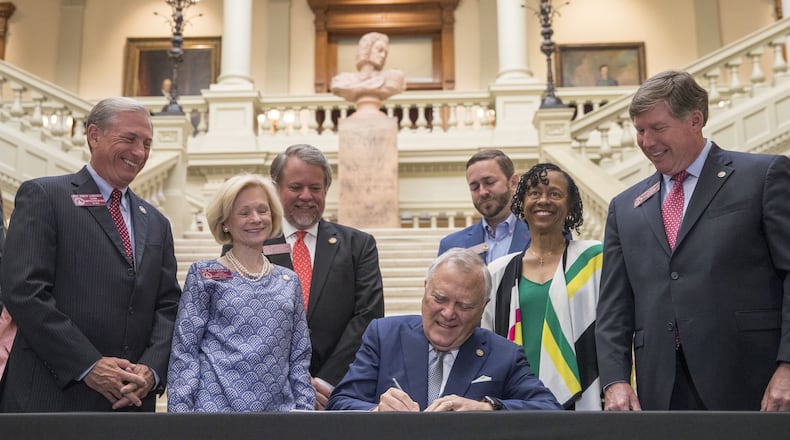Educators long complained that the state shorted public schools, but a booming economy is helping Gov. Nathan Deal and lawmakers keep that from happening again in the upcoming year.
Deal on Wednesday signed a historic $26.2 billion budget that for the first time in more than a decade fully funds the formula used to pay for the public schooling of about 1.7 million Georgia children.
The mood at the Statehouse bill signing was in stark contrast to revolts in Kentucky, Oklahoma, West Virginia and Arizona in which teachers have marched out of schools and into statehouses to demand higher pay and more money for education.
RELATED: Track the bills on Gov. Deal’s desk
In Atlanta, Capitol bill-signing ceremonies are typically formalities, but it was a big moment for Deal, who is retiring after this year and has been the target of attacks over “austerity cuts” in school funding that began long before he took office.
The governor said he hopes fully funding the school formula — which was created more than 30 years ago — will eliminate a major roadblock to eventually re-working and improving how the state pays for schools.
“Some excuses are now removed,” said Deal, who failed in his own effort to change the funding system. “I look forward to great results now that we have fully funded the formula.”
Deal made the decision to fully fund schools in the closing days of this year's Legislative session, after it became clear state revenues would allow it. Under the budget for fiscal 2019, which begins July 1, the state will be pouring $9.9 billion into k-12 schools.
The General Assembly was happy to go along with the move. After all, they, like Deal, have gotten an earful from educators over the issue.
"That is something that has been out there the entire 14 years I've served," said House Appropriations Chairman Terry England, R-Auburn. "It was always something in the background, it was something we wanted to do and wanted to do. To finally get it done … I can't describe what it feels like."
School groups, such as the Professional Association of Georgia Educators, the state’s largest teacher organization, applauded the work Deal and lawmakers did.
“Cuts to Georgia’s school funding formula began well before Deal was elected governor, and the ongoing austerity cuts lead to the elimination of important student programs, fewer days of student instruction, teacher furloughs and other painful cuts to schools across the state,” said Craig Harper, the executive director of PAGE. “We challenge Georgia’s next governor and Legislature to continue Deal’s legacy of investing in Georgia students and teachers.”
The so-called “austerity cuts” began in the early 2000s on the heels of a recession. When the Great Recession hit four or five years later, they began topping $1 billion a year — money that was supposed to go to schools but didn’t because of cutbacks at the statehouse.
That led to local property tax increases, teacher furloughs and shortened school years for students.
Deal whittled down the cuts for several years to about $166.7 million. When he sent lawmakers a letter in March telling them he expected more tax money to come in than earlier estimates, the first thing he recommended was that the money go to wiping out the rest of that deficit.
That means k-12 schools will receive $166.7 million more than expected in the upcoming year.
The new budget does not include state-funded pay raises for 200,000 teachers and state employees in the upcoming year. But it does contain $361 million to prop up the teacher pension system.
The budget also includes tens of millions of dollars designed to help boost the economy of small-town Georgia, and more than $1 billion in new spending for construction projects such as college classrooms and labs, roads and the continued deepening of the Savannah harbor to allow for larger cargo ships.
The new budget also includes $100 million in borrowing for unspecified transit projects and $16 million in grants to k-12 systems to improve school safety in the aftermath of February’s Florida campus massacre.
Most of the more than $1 billion in new spending next year will go to schools, colleges and public health care programs.
Deal held signing ceremonies in several parts of the state Wednesday, and for the outgoing governor, it was a bit of a fiscal victory lap.
He came into office in 2011 with the state still feeling the effects of the Great Recession. State government had relatively little money in savings, schools and agencies had weathered budget cuts and Georgia’s unemployment rate was over 10 percent.
When he leaves office in January, he will likely be handing his successor reserves topping $2.5 billion, better-funded schools and an economy that has grown, producing enough tax money to sustain a record state budget.
“When I came into office, we were not in great financial shape,” Deal said. “I am very pleased we were able to take the right approach and grow ourselves out of the down-turned economy. We did it by focusing on investments that we thought would pay the biggest dividends.
“Barring somebody making a huge mistake between now and the second Monday in January, I am going to feel very good,” he added, “and being able to hand over state government to the next governor in the kind of financial shape that I believe we will be in is satisfying to me.”
Here are some of the construction/capital projects included in the budget for fiscal 2019, which begins July 1:
$100 million for transit needs statewide
$100 million for bridge repair, replacement and renovation
$35 million to continue Savannah Harbor deepening project
$34.8 million to build an interdisciplinary STEM research building, University of Georgia
$30.6 million to renovate Price Gilbert Library and Crosland Tower complex at Georgia Tech
$23.5 million for construction of a new health sciences building, Chattahoochee Technical College, Marietta
$16 million for school safety improvement grants
$15 million for the Georgia World Congress Center to build a pedestrian mall
$12.5 million to renovate the Stone Mountain Inn and Evergreen Conference Center and Resort, Stone Mountain
$8.9 million to design, build and equip a new Center for Advanced Manufacturing and Emerging Technology, Chattahoochee Technical College, Acworth campus
$5.3 million for construction and renovations at Clayton State University
$5 million to design a new convocation center at Georgia State University
$5 million to renovate and equip Engineering Lab Building G at Kennesaw State
$5 million for design, construction and equipping a renovation of Library North, Georgia State University
$4.5 million for Lake Lanier Islands to design and build a new conference center
$3.5 million for a new Department of Driver Services center in Gainesville
$3 million to renovate and expand Russell Hall at the Health Science Campus, UGA
$2 million for design and renovation of Switzer Library in Marietta
$2 million for design and renovation of Hall County Public Library, Gainesville
$900,000 for design and renovation of Covington Public Library
$750,000 to buy land and expand parking at a Department of Driver Services center in Atlanta
About the Author
Keep Reading
The Latest
Featured


